We all know of Hiram Maxim for his groundbreaking work in machine gun development – but not many people are familiar with his automatic pistol designs. In fact, this is at least partly because the designs were not exclusively his – the pistol we are going to look at today is a design jointly patented by Maxim and one of his assistants, Louis Silverman. Silverman was one of the first people hired by Maxim when he began experimenting with firearms, and the man would eventually become a factory foreman in Maxim’s employ.
Maxim was a rather egotistical man, and not one interested in sharing credit or accolades. Anyone with a reasonable knowledge of Maxim’s character is left with little other conclusion but that any man Maxim would be willing to share a patent with must have contributed a very significant portion of the work involved, if not a majority of it. It is worth pointing out that these automatic pistol designs are mentioned nowhere in Maxim’s autobiography, and that at least one photo therein (of Maxim and Silverman helping future King Edward VII shoot an 1885 Maxim machine gun) was edited to remove Silverman’s appearance.
Anyway, before I lay too much criticism at Maxim’s feet, let’s take a look at this 1896 pistol design. FYI, the photographs in this article are all taken from the James D. Julia auction house, which is bringing one of the 3 existing such pistols up for sale…
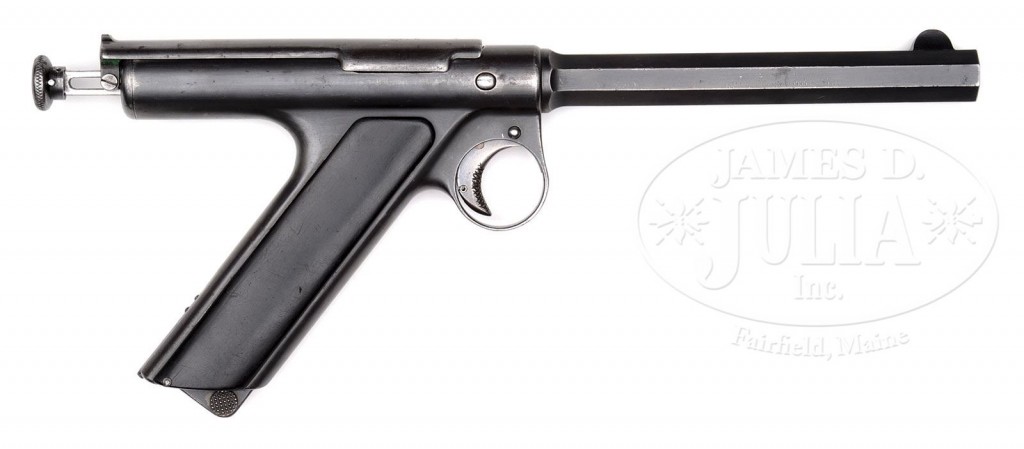
Compared to virtually every other handgun in production in 1896, the design looks strikingly modern – anyone not familiar with it could probably be easily convinced that it was a prototype Ruger. It is also remarkably simple for such an early design. While most of the other handguns on the market were using complex locking mechanisms like the Borchardt’s toggle lock or the blocks and wedges of the Mannlicher and Mauser guns, the Maxim-Silverman was a simple blowback design. It used a single spring as both recoil spring and firing pin spring, with the firing pin cocking by inertia at the end of the recoil stroke. That is to say that the firing pin floated inside the bolt under pressure from the mainspring. Recoil would throw the bolt and firing pin backwards, and the firing pin would continue moving rearward after the bolt had stopped, thereby locking behind the sear and becoming ready to fire again once the bolt closed on a new cartridge. The spring-loaded sear was located on the bolt instead of the frame to accomplish this, one of the elements protected by the Maxim-Silverman patent:
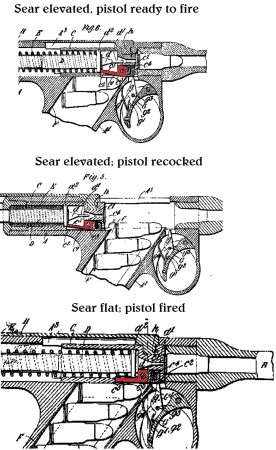
Another clever element in the design was the use of a floating ejector, which was pushed out to eject a case by a cam in the back of the receiver. This was a novel idea at the time, and would later become quite common, especially on machine guns.
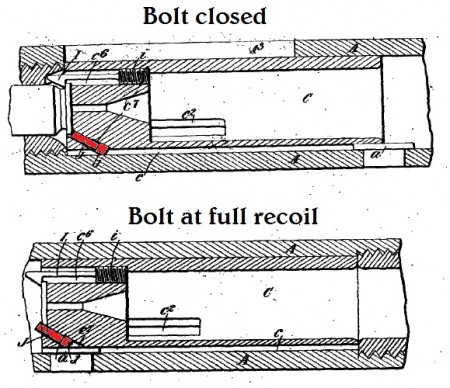
By this point, looking at the clever ideas embodied, one begins to wonder why there pistols didn’t become popular, and better known. It appears that the main reason lies in the inventors’ choice of ammunition. The first cartridge chosen appears to have been the 7.65mm Borchardt (one of the existing 3 examples is in this caliber), which was available at the time because of the C93 pistol. That cartridge, however, is rather overpowered for this blowback design. A second existing pistol (the one photographed here) is chambered for a unique cartridge which appears to by the Borchardt round necked up to .333 inch/8.45mm (R.K. Wilson misidentified this as 8mm Schonberger in his otherwise-excellent Textbook of Automatic Pistols). This larger bullet was no improvement for functioning. In fact, a modification was made to the design in an attempt to delay the bolt blowback, which is visible on the left side of the pistol. An opening was cut in the receiver, and a beveled cutout made in the side of the bolt. A matching beveled flat spring was screwed to the side of the gun, so that the bolt would have to force it out of the way before it could travel backwards, thus adding a significant amount of resistance to the action.
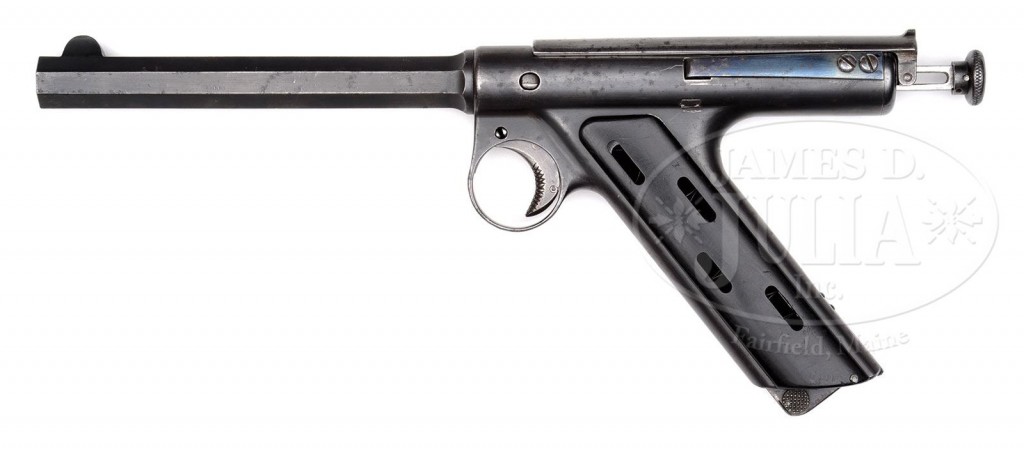
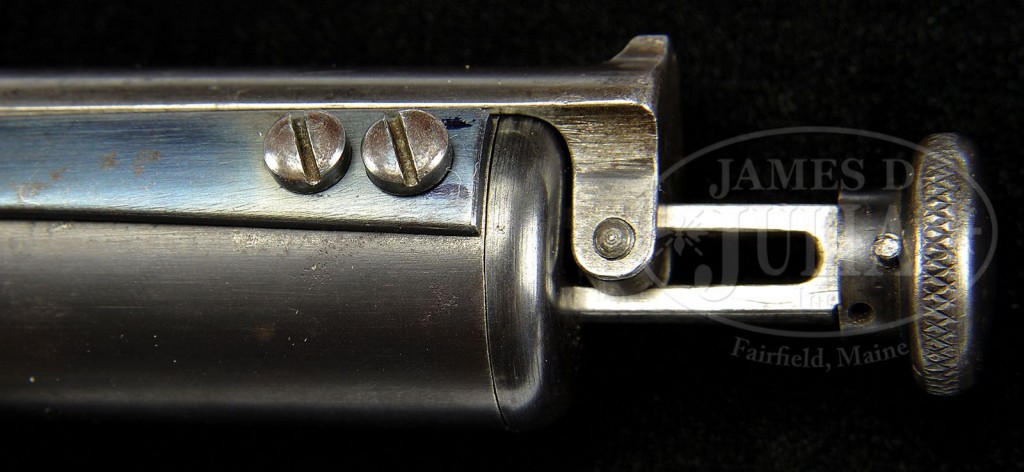
The third known existing example of the pistol is chambered for a .455 Webley cartridge and is a monster of a pistol, being both longer and heavier than a .450 caliber Mars automatic.
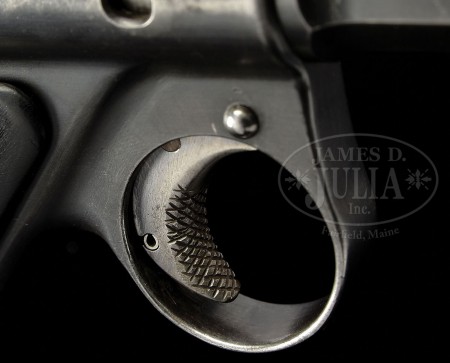
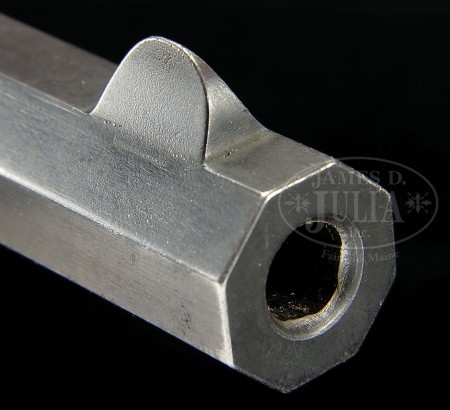
So, we can see that the initial patent design, while it had many clever and innovative elements, was unworkable in the caliber chosen. This would have been fixable as the added spring on this pistol shows (or by reducing the caliber and working to a civilian rather than military market), but something else was holding the pistol back. At the time he was working on the design (and really, it is more likely that Silverman was doing the brunt of the work), Maxim was tremendously preoccupied with development of his machine gun, and upcoming acquisition by the Vickers company. He likely chose not to allocate any serious resources to back the pistol development, and left it to die on the vine. Unfortunately for Silverman, it may well have been simple ego and jealousy that prevented this quite promising design from ever seeming production.
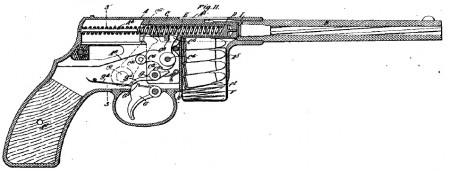
Before we conclude, we should take a further look at the Maxim-Silverman patent. It actually includes three different designs. The first is the pistol photographed here. which is the only one of the designs actually built. The second design appears to have been more Maxim’s idea than Silverman’s, as it shares a few basic elements but includes a number of fire control parts that look suspiciously like pieces of a Maxim machine gun lock. The third design is a variation of the first, and it contains the potential seed of another way to solve the pistol’s over-power problems: a lever-delaying system like that later patented by Király…
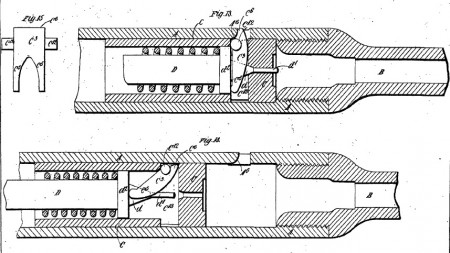
Who knows what might have changed if Silverman had been able to get a backer for his work…
Patents
Great Britain Patent #29836, year 1896.
Bibliography
Goldsmith, Dolf. The Devil’s Paintbrush: Sir Hiram Maxim’s Gun. Collector Grade Publications, 2002 Expanded Edition.
Sturgess, Dr. Geoffrey L. “Maxim’s Pistols”. Journal of the Historical Breechloading Smallarms Association, Volume 2 Number 6.


When I first looked at the Maxim-Silverman pistol I thought there must be more than 3 left because my Mother had one in the 1950 s. It had been chrome plated and converted to run on Butane. They mustn’t have worked well as a pistol as it had been converted to a much more civilian task of lighting cigarettes. I remember it well and did a Google search and found several for sale now, http://www.ebay.com/itm/VINTAGE-GUN-SHAPED-MATCH-O-MATIC-BUTANE-GAS-MATCH-ORIG-BOX-PAPERS-JAMES-BOND-/171130796540 . I am sorry to waste your time on this but they really look the same. The 16 shot Nambu and early Erma 22 cal target pistols are also is called to mind by the grip angle, The small fragile looking sear and ejector look like they would be subjected to a lot of wear and shock leading to malfunctions. Bob
I also love the look of the front sight following the line of the barrel flats.
Very good study material! My observations would be:
1. even for more suitable cartridge, the inertia cocking looks potentially unreliable (I thought about it myself one time in past); does anyone know about any other case of such design application? Spring combination function is slick but leads to some limitation.
2. spring use to delay action is courageous while somehow unrealistic, it needs lot more resistance although, geometry and sturdiness play important role too; a delay lever (which they attempted in 3rd design but for different reason) might have been incorporated between both breech parts resting with one end temporarily resting against receiver; in that case the return spring would need to be relocated and separated from firing pin function; design would loose its original simplicity and shine
3. the third idea looks very nice; however let’s recognize that the lever is not serous enough resistance to blowback, but for firing pin cocking purpose it is super; I believe Browning had similar idea for cocking on 1919 MG.
They are really clever ideas which were unfortunately not drawn up to mature design. Designers of today should be able to take a note or two. Thanks for showing!
In his article, Sturgess says that comparing the .455 example (which does not have an added flat spring) to the smaller version, the spring increases the resistance on the bolt by more than 10kg, which is pretty significant. I would be interested to see a photo that more clearly showed how the spring and bolt interface – with that amount of added resistance it’s clearly not just friction.
Twenty two pounds pull just to start to move the bolt, even more to cycle the action – ouch.
It does make you wonder whether Maxim and Silverman actually understood the role of inertia, as opposed to the push of a spring.
The inertia spring system actually kinda reminds me of the FG-42, although that design also uses an additional booster spring to provide more power to the firing pin.
Thanks for this very infoormative post.
A single power source with dualserving as main and return springs is realy
overclever. Using the sear to push the breechbolt to foremost position and
inetia for the striker to the rearmost are also either.
Thanks again.
Very neat! If they had kept this in development until 1903 it might have worked well in 9mm Browning Long. And suddenly I have the darnedest urge for a Mk III Ruger with a long, slim octagon barrel.
Are there any benchmarks on what a gun this this unusual goes for at auction these days? The book blog in my local paper recently did a thing on the upcoming auction of one of few surviving copies of the 1640 Bay Psalm Book (first book printed in the English colonies) and it is expected to go for 15 to 30 million. (The article pointed out that the last sale of a copy of this book was in 1947 for $151,000, and a Renoir that sold at the same time for $80,000 recently went for $28 million.) This is in .45ACP Luger territory in scarcity, if not value.
I don’t know of any recent sales…Julia says the expected price for this one is $20k-$30k. It may be extremely rare, but it doesn’t appeal to the large group of people that a .45ACP Luger does.
I would … totally consider buying a slightly refined version in .22LR, or perhaps .32ACP.
What surprises me is how close that 3rd lever delay design is to the later roller locked/delayed designs. Can you imagine WWI with MG 42?
That really could have been over by Christmas.
although the senior generals would likely have found some way to employ the gun which ignored all of its advantages and made it depend on its weaknesses.
One way or another, the pre war days of passport and visa free travel, money that hadn’t inflated for 200 years, total tax take of around 3% to 5% of GDP, virtually zero unemployment, no zoning laws and next to no gun laws.
were going to be forcibly taken from us – for our own good of course.
It’s little off the topic again, but what you say is based on truth. This ‘great war’ was act of artificiality an treachery(and futility). There was no need for it at all. One more sentence – and I am in minefield of conspiracy. Why all people do not call things the way they are?
BTW people say ‘generals’. right…. generals had their ambitions, true. But they were taking orders from politicians or even better, emperors. Who was behind those, we can only guess. Case in point: American involvement. General population did not wont to do anything with ‘European’s war’; yet, they popped in action rather quickly after Wall street blew the whistle. We have reminder of it in every town.
The fear of Britain concluding peace with Germany, then defaulting on its war bonds, which the cronies on Wall Street were all to heavily invested in, allied with the post millenialist Wilson regime’s search for a suitable crisis as a pretext for its schemes of central planning.
I was going to describe it as a war with no winners, only losers, but that isn’t true.
Getting onto the safer ground of a previous series of wars, before the Battle of Waterloo, general consensus in London was that Napoleon’s forces would triumph, and the British government would default on its war bonds.
A former colleague who’d married into one of the British merchant banking families, told me that the Rothschild family were observing the battle from a nearby hill, no doubt with fine wine and food, as was traditional – as in those days, wars were fought between armies, whole populations were emphatically not targeted.
They also had baskets of carrier pigeons.
When, after noon, the tide of the battle turned and Wellington’s forces started to prevail, the Rothschilds released pigeons with the message “buy war bonds”.
In London, holders of war bonds were glad to get some money, any money, for what they believed was worthless paper.
That move was what was claimed to have taken the Rothschild bank into the big time, and the bonds continued to yield them interest until the Thatcher regime paid off the principal, in the 1980s.
Oy, the usual right wing blaming of the International Bankers (aka Jews) behind everything? Give me a f’ing break. Please stick to firearms where y’all might not make a fool of yourselves
That’s a very enlightening missing piece to the historical puzzle, so to speak. Truth is often stranger than fiction, yet what you have posted somehow doesn’t surprise me at all. Such are the ways of the world, and of the rich and powerful.
Actually, its a myth that gold or gold backed currencies did not inflate. They did each time the supply of gold increased. Each major gold rush in the 1800s produced a brief but significant bout of inflation and the introduction of the cyanide extraction method in the 1870s increased gold supply by IIRC nearly 50% in less than a decade.
That all turned out to be a good thing because the big problem with gold currency in the industrial is inflation’s polar opposite deflation. When you have constantly rising productivity, a fix amount of gold will buy more of any particular good, grain, labor, steel etc tomorrow, than it will today. It’s like automatic interest payments without having to lend or invest.
That sounds great, and it is, if you are already sitting on a pile of gold when the deflation begins. (Just as inflation is good if you have real assets like land.) If however, you are trying to sell something in exchange for gold, such as your labor, its a problem, because all your buyers know that if they wait, they get a better deal. Just as with inflation, deflation benefits the wealthy at the expense of middle-class. It hurts the poor worse than inflation because they can’t get jobs and with no income stream and no assets they start to hurt immediately.
Money’s only purpose is to communicate the relative value of different trade goods in the economy. People should buy and sell based on what they believe they need at any given moment. The price they pay communicates to everyone else what goods or services are needed. Inflation and deflaiton both destroy the communication function of money by forcing people to make economic decisions based on the value shift of the money itself. In inflation people buy things they may not want or need just because if they don’t, they have to convert money into some kind of asset before it looses its values. Conversely, in deflation, people don’t buy things they want or need because hope to get more at a later date. Either way, the price signals turn to noise and gibberish.
Although few understood it at the time, the introduction of fait currency was an attempt to create a currency that would inflate in sync with constantly increasing productivity. Ideally, if the economy grew 2% every year, then so would the money supply. It does work, providing there is discipline in the central bank. Switzerland and post-War Germany being noted examples. However, its more common than not for the urge to meddle with the money supply for political reasons to overwhelm prudence and you get inflation.
(Inflation also serves as an automatic flat tax which funnels money from the general populace to the central bank, which buys government bonds with it. That’s why inflation is used by 3rd world countries to pay off external debts denominated in other currencies.)
Fiat currency sucks but the dream of returning to gold is utterly impossible. The economy would freeze solid in just a few years.
Can you imagine WWI with MG 42?
It wouldn’t have change much. The problem with machine guns in WWI wasn’t weight, rate of fire or sustainability, it was the doctrines that controlled their use. Initially both sides treated them as a kind of lightweight, line of sight cannon with shrapnel charges instead of being a big rifile with a high rate of fire.
The real innovation came when the Germans and a small neglected group of French Alpine troops, developed what the Germans called “Strum” or Storm trooper tactics and the English speaking world call infiltration tactics. In either case, it involved the use of independently operating small fire teams comprised of less than a dozen soldiers all centered around a heavy weapon like machine gun, mortar, anti-material rifle etc. The word “infiltrate” originally meant “to ooze into” and with infiltration tactics, fire teams could cross killing grounds and break into trench lines easily. In the last year of the war, the Germans could break any line at any point they choose, often without using any artillery at all. They simply didn’t have the man power to exploit the holes they punched.
It’s a little know story but Americans were taught infiltration tactics from the get go by some of the most experienced and harden soldiers in the war. French alpine troops had developed the tactics to deal with broken terrain but the high command did not grasp their general utility. After fighting for two years, fewer than 10% of the original soldiers were still fighting. The French command viewed them as useless and burned out so the palmed the job of teaching the green Americans how to fight. Instead of teaching them how to fight line abreast in the trenches, they taught them how to infiltrate.
That’s why the Americans came as such a shock to the Germans. They expected green troops from a weak “commercial” culture to be ineffective but many American units were using the Germans own tactics.
Looks like something a Jules Verne character would be armed with while looking for moon men or for creatures under the earth.
A very clean and streamlined design with compact internals ; one can tell that Mr. Silverman put a great deal of thought and effort into it, in spite of the management and financial odds he was probably being subject to given the circumstances, Hiram Maxim’s pre-occupation with other matters, and Maxim’s undoubtedly enormous ego.
As Denny has astutely pointed out, there could have been a lot of potential in the design , if only it had been allowed to mature and evolve.
It would be really interesting if, at some point, a modern-day gun manufacturer picked up where Silverman left off and applied those evolutionary improvements to the design while making it available to the firearms community.
I am guessing I am the only one who looked at the first picture and went “oOo sinister lines”
Pffft. Sam, you should know better than that….I read this forum too…LOL.
Before the beginning of last century, people might not be awared what others
had been going to do. Therefore, ınventors like, Browning, Searle, Revelli, Nambu
and Kiraly might create their own ideas without getting started by inventions
of Mr. Silverman. But from the historical point of view, Silverman is the
forerunner of trigger mechanisms of Glisenti, Nambu,Savage 1907 and Browning HP, and
even the forerunner of lever and roller delayed blowback firearms of today even if
invention was not intented to do so.
Gas escape hole at left side and ejector port cover at to, both reveal that Mr.
Silverman was aware about his blowback pistol’s gas lose feature. But his way to
cycle the mechanism is brilliant. There is more than enough momentum to throw the
breechbolt and sear to the back until each one to stop as striking their stoppers
and especially inertia of sear should not be important to carry out this function.
Lever accelerator of third type, though stated in patent specification, intented
only to get ease of pushing the sear back and providing somewhat weaker return or
main spring for manual traction, functions exactly what a delay lever would do, as
saving excess momentum from accerelated and lightened sear and mainspring and
adding it over the broeechbolt as increasing its weight and slowing its speed within
the vital distance from the start to the lever hook release off the receiver which
highest level of gas pressure occurs, as the same which was patented in 1913 with
SN.1073908,in The USPTO by Pal Dedai Kiraly and Josef Lovasz.
You know, anything which is supposed to happen based just on quickly vanishing pressure is kind of tricky and less than reliable. It is lot better to have momentum stored in some free mass and have it to do what is needed in longer span of time later. One such example of efficiency is free coasting slide of modern pistol. It works consistently and reliably.
Your initial note on lack of awareness among designer’s advances probably led to multiplicity of ‘inventions’ which were often just duplications of each other’s work. But to some degree, it was era of revolution in small arms, no doubt about it.
Thanks for the detailed information. I’ve always thought the Maxim-Silverman was an interesting looking gun, but never had this level of information.
It looks like a cross between a Ruger MkII and a first model Japanese Type 14.
It’s interesting that they thought that the action would be amendable to 7.63 Borchardt. Of course there wasn’t a lot of prior work to build on.
Hi, Denny,
As everytime is, You are right. By the way, the simple and sleek design of this
pistol just reminds another prototype stage gun of this era, Scwarzlose M 1898
which was a brainchild of another machinegun creator. Andreas Schwarzlose.
Oh yes, Schwarzloze, that’s in my old empire’s territory – Austria-Hungary. The Schwartzlose machinegun was made after WWI in Skoda Plzen and became standard issue heavy machine-gun before vz.37. As far as pistol, I’ll look at that.
And you are right, regardless of the mechanical ‘details’, this pistol is amazingly slick in appearance; completely above its time.
Inertia approach reminds that Mr. Val. Browning
also borrowed some ideas from Mr. Silverman’s design
for his “Double Automatic” shotgun.
Hi Strongarm and Denny.
In the days before the green movement, it is amazing how much recyling was going on – recycling of already existing ideas into patents.
Andreas Schwarzlose’ 1898 pistol was recycled, with the rotating bolt and the lahti like accelerator lever into Harry Sandford’s early 1970s Automag (link to automag patent on the Clausius page). Sanford eventually succumbed to reason, and his later AMT “Automags” used Browning slides.
The Clausius patents which Ian has linked to, show a williams floating chamber, patented several months before David Williams was born, and what appears to be a freely axially moving barrel, half a century before kimball
https://www.forgottenweapons.com/prototype-clausius-model-1905/#comments
and while checking for any patent info on the overly deep rifling for the H&K VP70 pistol, it appears that H&K had patented a 4 groove version of Charles Lancaster’s oval bore – or alternativly a version of Metford’s segmental rifling, over 100 years after their invention.
It is possible that ideas popped up independently. It is very much human trait that while seeking same objective, results are often very close.
I looked at referenced materials and indeed, the Clausius pistol looks well developed. I do not see nothing which had to be potentially unreliable even with that inertia based cocking. As long as parts get their dose of lube, I suppose.
Also I noticed that in one of his original (Swiss registered) patents was rifle with rotating head bolt using helical grooves. Here we go, Schmidt&Rubin.
@ Keith, Strongarm & Denny :
Quite so, gentlemen, quite so. Very logical and informative observations, to say the least. Many thanks, as usual :).
Thanks in response, Earl,
I would not like to be off topic, but, it should be stated that, Patent examiners
should be at a level, at least, in a par with inventors on research flexibility
and orientation into new ideas for evaluation of a new concept. In reality, most
of them are medium grade lawyers.
i must be missing something, how can one expect the inertia of the firing pin to consistantly cock with manual operation, i.e. when reloading, it seem like if you didn’t cycle it forcefully enough by hand it would fire when the bolt closed, no?
…unless the firing pin is attached to the cocking piece, which it seems to be…